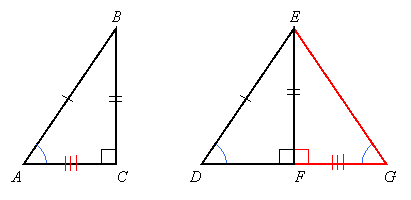
Right Triangles
HL
SSA or ASS is not a theorem in geometry because two triangles that are not congruent can satisfy this condition:

However, if the angle is a right angle, then the triangles are congruent. This is a theorem, called HL for "hypotenuse-leg."
Theorem (HL):
If two right triangles have congruent hypotenuse's and a pair of congruent legs, then the triangles are congruent.
We can prove this theorem by setting up two triangles that satisfy the HL hypothesis:
Given: ![]() and
and ![]() are right angles,
are right angles, ![]() , and
, and ![]()
Prove: ![]()

Proof:
Let ![]() be a point on the ray opposite
be a point on the ray opposite ![]() so that
so that ![]() , and draw
, and draw ![]() as in the picture on the right. Because
as in the picture on the right. Because ![]() is a right angle,
is a right angle, ![]() is also a right angle, and therefore congruent to
is also a right angle, and therefore congruent to ![]() . So
. So ![]() by SAS.
by SAS.

Therefore ![]() . Since
. Since ![]() , the transitive property tells us that
, the transitive property tells us that ![]() . That shows
. That shows ![]() is isosceles, so
is isosceles, so ![]() .. Since
.. Since ![]() ,
, ![]() , and (using the transitive property again),
, and (using the transitive property again), ![]() . Now we can conclude that
. Now we can conclude that ![]() by SAA.
by SAA.

The Perpendicular Bisector Theorem
We have discussed this before, and now we will give a precise proof:
If a point is equidistant from the endpoints of a segment then it is on the perpendicular bisector of that segment, and conversely.
There are two things to prove here, a statement and its converse, so we will split the proof into two parts, using generic diagrams for each.
Statement:
If ![]() then
then ![]() is on the perpendicular bisector of
is on the perpendicular bisector of ![]() .
.

Proof:
Let ![]() be the midpoint of
be the midpoint of ![]() and draw
and draw ![]() :
:

Then ![]() by SSS. Therefore
by SSS. Therefore ![]() since these are corresponding parts of the congruent triangles. But these angles are a linear pair, so their measures add to 180o. Since they are congruent angles, each must measure half of 180o, which is 90o. Therefore
since these are corresponding parts of the congruent triangles. But these angles are a linear pair, so their measures add to 180o. Since they are congruent angles, each must measure half of 180o, which is 90o. Therefore ![]() . So
. So ![]() is on the perpendicular bisector of
is on the perpendicular bisector of ![]() (by definition of "perpendicular bisector").
(by definition of "perpendicular bisector").
Converse:
If ![]() is the perpendicular bisector of
is the perpendicular bisector of ![]() then
then ![]() .
.

Proof:
Because ![]() is the perpendicular bisector of
is the perpendicular bisector of ![]() ,
, ![]() , and
, and ![]() since both are right angles.
since both are right angles. ![]() is a common side to
is a common side to ![]() and
and ![]() , so these triangles are congruent by SAS. Therefore
, so these triangles are congruent by SAS. Therefore ![]() since they are corresponding parts of the congruent triangles.
since they are corresponding parts of the congruent triangles.

The Angle Bisector Theorem
If a point interior to an angle is equidistant from its sides, then that point is on the bisector of that angle, and conversely.
Again we have a statement and its converse to prove:
Statement:
If ![]() ,
, ![]() , and
, and ![]() then
then ![]() bisects
bisects ![]() .
.

Proof:
From the hypothesis, ![]() and
and ![]() are right triangles with congruent legs
are right triangles with congruent legs ![]() . They also share a common hypotenuse:
. They also share a common hypotenuse: ![]() . Therefore
. Therefore ![]() by HL. Thus
by HL. Thus ![]() since they are corresponding parts of the congruent triangles. So
since they are corresponding parts of the congruent triangles. So ![]() bisects
bisects ![]() since this is the definition of "bisects."
since this is the definition of "bisects."
Converse:
If ![]() bisects
bisects ![]() ,
, ![]() , and
, and ![]() then
then ![]() .
.

Proof:
Since ![]() bisects
bisects ![]() ,
, ![]() (by definition of "bisects"). In addition,
(by definition of "bisects"). In addition, ![]() and
and ![]() are right triangles with common side
are right triangles with common side ![]() . So
. So ![]() by AAS. Therefore
by AAS. Therefore ![]() since these are corresponding parts of the congruent triangles.
since these are corresponding parts of the congruent triangles.

The Angle Bisector Theorem for Isosceles Triangles
In an isosceles triangle the bisector of the vertex angle cuts the opposite side in half.
Note: The vertex angle of an isosceles triangle is the angle which is opposite a side that might not be congruent to another side.
To prove this, we rephrase it with a generic isosceles triangle:
If ![]() and
and ![]() bisects
bisects ![]() then
then ![]() .
.

Proof:
Since ![]() bisects
bisects ![]() ,
, ![]() .
. ![]() and
and ![]() share a common side,
share a common side, ![]() , and it is given in the hypothesis that
, and it is given in the hypothesis that ![]() . Therefore
. Therefore ![]() by SAS. As a consequence,
by SAS. As a consequence, ![]() since these are corresponding sides of the congruent triangles. So the lengths
since these are corresponding sides of the congruent triangles. So the lengths ![]() . But
. But ![]() by the segment addition postulate, and therefore
by the segment addition postulate, and therefore ![]() (using substitution in algebra).
(using substitution in algebra).

Something to Think About
If the triangle were not isosceles, then would an angle bisector cut the opposite side in half? For example, if ![]() and
and ![]() bisects
bisects ![]() then is it still true that
then is it still true that ![]() ?
?

The answer is no as you might notice from the diagram. We will see in a later lesson after we discuss similar figures that ![]() and
and ![]() are proportional in the same way that the sides
are proportional in the same way that the sides ![]() and
and ![]() are.
are.